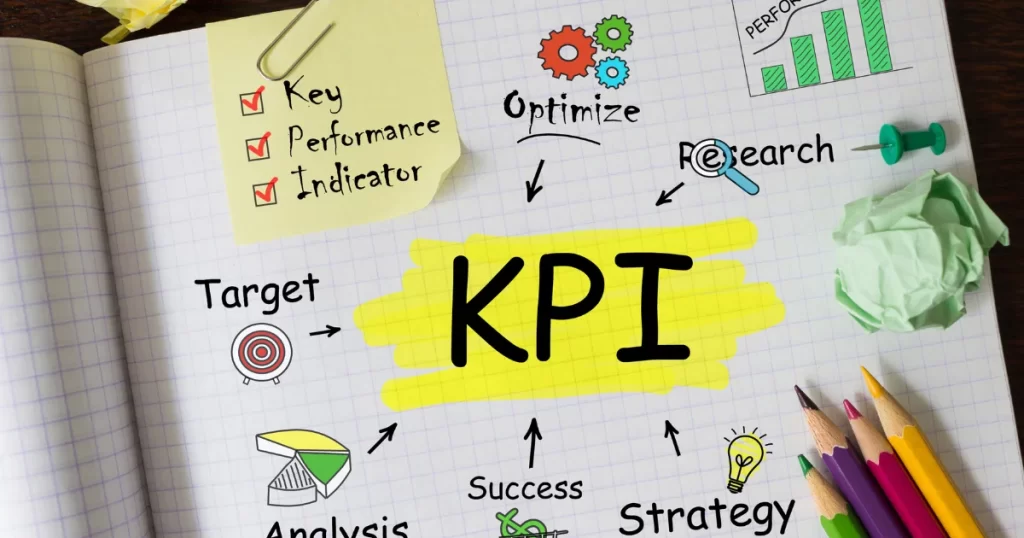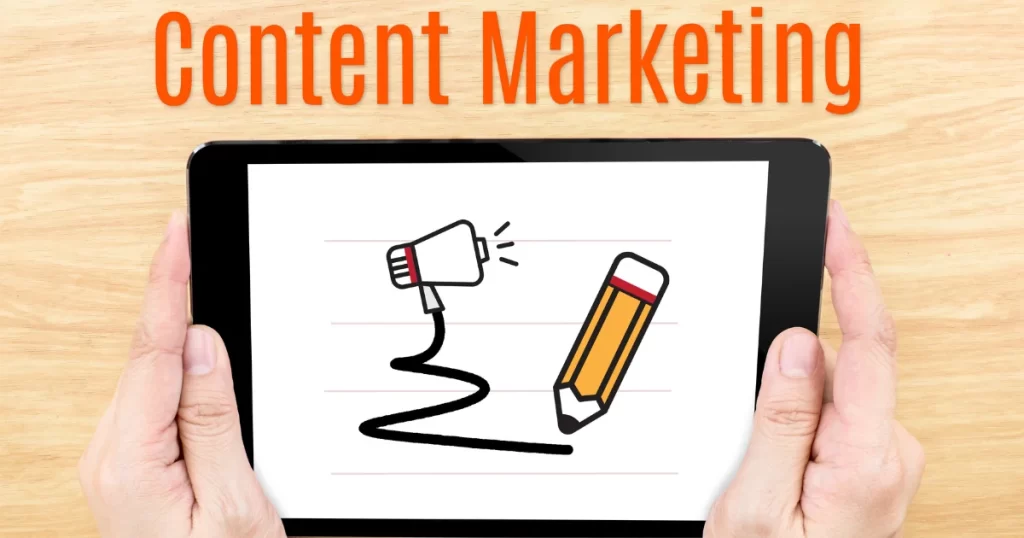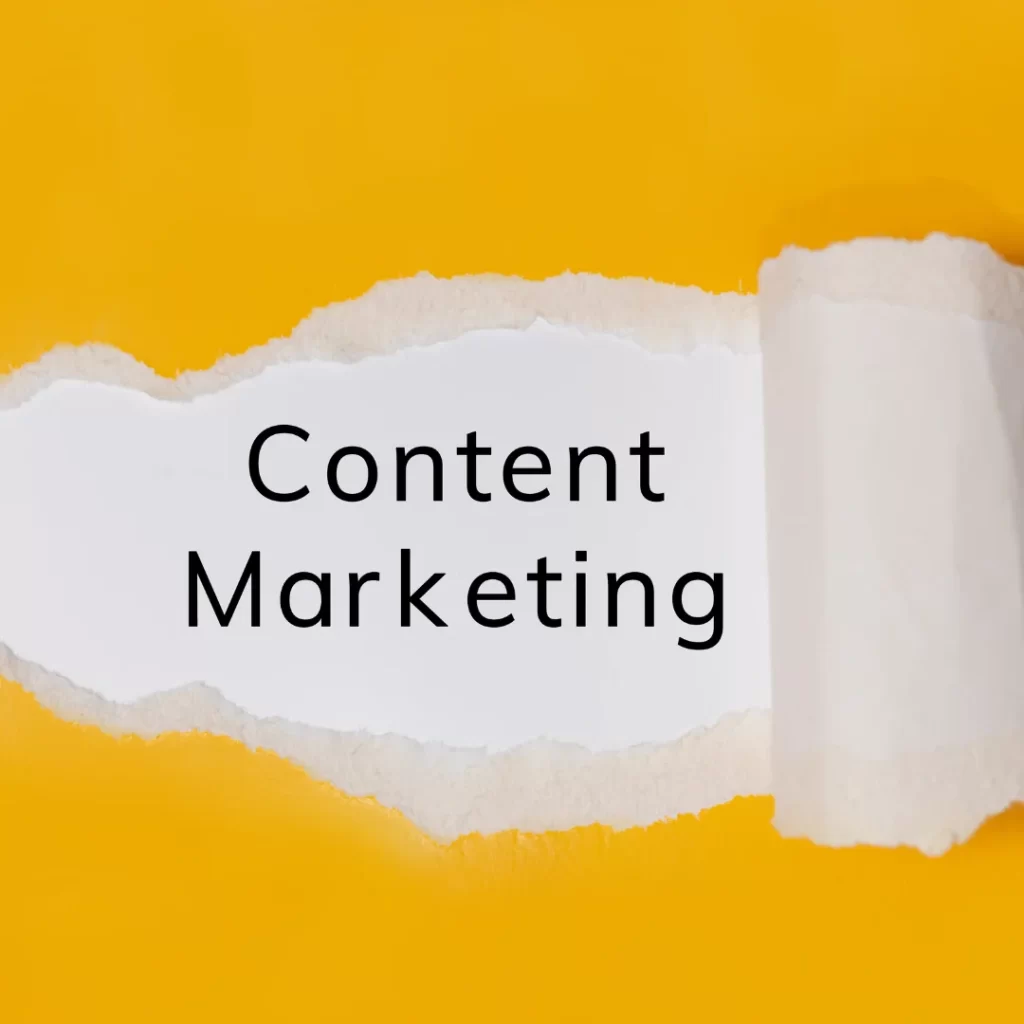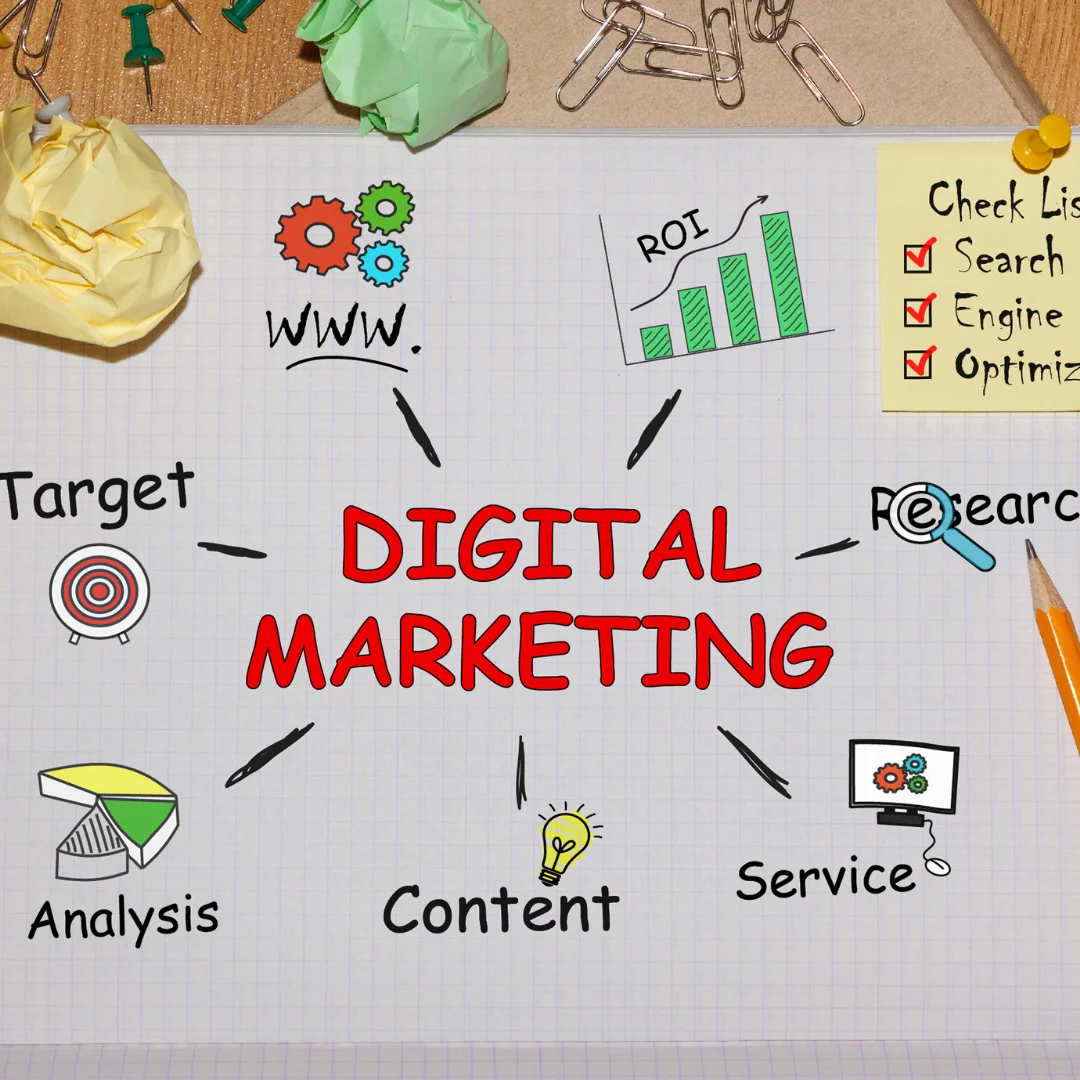Content marketing has become a linchpin in digital marketing, offering businesses an efficient and versatile approach to build awareness, trust, and conversions with target audiences. By crafting valuable and relevant content, companies can foster long-term engagement, boost brand visibility, and encourage profitable customer actions.
This article will walk through five major types of content marketing—each with its unique strengths—before covering strategies to get the most out of your efforts, KPIs to measure impact effectively, and examples of brands with standout content campaigns.
Types of Content Marketing

Content marketing takes many forms, allowing businesses to connect with audiences in diverse ways. Each type of content can engage audiences, build trust, and position a brand as a leader in its industry. Here’s a deeper look into five primary types of content marketing.
Blog Posts
Blog posts are a foundational piece of any content marketing strategy. With SEO-optimized blog posts, brands can share detailed information, offer solutions, and showcase their expertise on relevant topics.
Benefits of Blog Posts in Content Marketing
Blogging remains one of the most effective ways to improve search engine visibility and organic traffic. Consistent, high-quality blog content that addresses audience pain points builds authority and encourages readers to return for valuable insights. Blog posts also drive traffic to specific products or services, with content that answers questions and guides readers through the decision-making process.
Example of Effective Blog Post Strategies
One of the leaders in content marketing, HubSpot, has a blog covering topics in marketing, sales, and customer service that attract high traffic volumes. HubSpot’s content is rich in detail, using SEO to rank high in search engines, while addressing topics its readers care about deeply. This approach not only builds credibility but also brings in substantial organic traffic.
Videos
Videos have emerged as a powerful form of content marketing. They are highly engaging and effective at conveying complex information in a digestible, visual format. From explainer videos to product demos, videos engage users and drive conversion.
Benefits and Impact of Video in Content Marketing
According to Wyzowl’s annual State of Video Marketing survey, 87% of marketers report a positive ROI from video content. Videos provide a medium that captures audience interest quickly, with statistics showing that people retain 95% of a message when they watch it in a video versus only 10% when reading it in text form.
Types of Effective Video Content
- Short explainer videos: These provide a brief overview of a product or concept, helping viewers quickly understand its benefits.
- Tutorials and how-to guides: Tutorials provide step-by-step instructions, positioning a brand as a helpful authority.
- Live streams and webinars: Live video formats are highly interactive, allowing brands to connect with their audience in real time.
Infographics
Infographics are highly visual and data-driven, making complex information easy to understand at a glance. They’re also incredibly shareable on social media, which helps in amplifying a brand’s reach.
Best Practices for Impactful Infographics in Content Marketing
- Clear Design: An infographic’s power lies in simplicity; only essential data should be included to avoid overwhelming viewers.
- Readable Font: Fonts should be large enough to read easily, particularly when shared on platforms like social media.
- High-Quality Visuals: Platforms like Canva offer templates that help create professional-looking infographics even for beginners.
Infographics are a fantastic way to condense key points, statistics, or processes into a single image that is both informative and engaging.
E-books/Whitepapers
E-books and whitepapers are valuable resources in content marketing, offering in-depth knowledge that audiences find useful. Often available as gated content, they help generate leads by requiring a download in exchange for contact details.
Role of E-books and Whitepapers in Lead Generation
These formats work well for brands targeting B2B audiences, as they often contain industry insights or extensive research. By positioning a brand as a trusted source, e-books and whitepapers can significantly improve lead generation and nurture prospects toward making a decision.
Examples of Successful E-book Strategies
The Content Marketing Institute (CMI) publishes yearly B2B reports filled with valuable insights. By requiring users to fill out a brief form to access these resources, CMI not only distributes high-quality content but also builds a list of engaged leads.
Podcasts
Podcasts have gained popularity in recent years, offering a unique, audio-driven way to engage audiences. They are an excellent form of content marketing for building a dedicated following and are particularly effective in reaching busy listeners who enjoy learning while on the go.
Benefits of Podcasts in Content Marketing
Podcasts provide a platform for storytelling, industry insights, and thought leadership. They create brand intimacy, with listeners often developing a strong connection with the hosts and guests. As podcast listeners tend to be highly loyal, this format is particularly effective in nurturing long-term relationships.
Advantages of Podcasts for Audience Engagement
- Convenience for Multitasking: Audiences can listen while commuting, exercising, or doing daily tasks.
- Low Production Barrier: Podcasts don’t require an extensive production setup, making them accessible for brands of any size.
- Builds Authority: Featuring guest experts in podcasts further enhances a brand’s credibility and authority in its industry.
By sharing unique perspectives, brands can position themselves as thought leaders in their fields, encouraging listeners to follow their insights regularly.
Best Strategies for Content Marketing

For content marketing to succeed, a well-planned strategy that aligns with business goals and effectively engages the target audience is essential. Here’s a breakdown of the top strategies to help you build an impactful and result-oriented content marketing plan.
Developing a Clear Content Strategy Aligned with Business Goals
Creating content without a clear strategy is like driving without a map; it’s easy to lose direction. To ensure content marketing efforts contribute to overall business success, every piece of content should serve a purpose aligned with specific goals, such as brand awareness, lead generation, or customer retention.
Steps to Build an Effective Content Marketing Strategy:
- Define Business Goals: Identify the top business objectives you aim to achieve through content. For example, if increasing sales is the goal, your content should guide audiences through the buyer’s journey, offering valuable information at each stage.
- Understand Your Audience: Conduct audience research to understand their demographics, interests, and pain points. This helps in creating content that resonates deeply with their needs and preferences.
- Map Out Buyer’s Journey Stages: Outline content topics that cater to each stage of the buyer’s journey (Awareness, Consideration, and Decision). This helps in addressing specific needs at the right time, guiding prospects toward conversion.
- Set KPIs and Measure Progress: Define clear KPIs like organic traffic, social engagement, or conversion rates, and monitor these metrics regularly to gauge the impact of your content.
Table 1: Aligning Content Types with Business Goals
| Business Goal | Content Type | Purpose |
|---|---|---|
| Brand Awareness | Blog Posts, Infographics | Educate audience on industry topics |
| Lead Generation | E-books, Whitepapers | Capture leads through gated content |
| Customer Retention | Email Newsletters, Videos | Nurture relationships, share updates |
| Sales and Conversions | Case Studies, Testimonials | Build trust and encourage purchases |
SEO Techniques to Enhance Visibility
Visibility is crucial in content marketing, and Search Engine Optimization (SEO) is key to increasing your reach on search engines like Google. SEO techniques help ensure that your content is not only found but also resonates with your target audience.
Essential SEO Techniques for Content Marketing Success:
- Keyword Research: Use tools like Ahrefs, SEMrush, or Google Keyword Planner to discover high-potential keywords relevant to your industry. For effective content marketing, focus on long-tail keywords that attract more specific, intent-driven traffic.
- On-Page Optimization: Include primary keywords in critical areas such as headings, subheadings, and within the first 100 words of your content. This helps search engines understand the main topics of your content.
- Technical SEO: Make sure your website’s loading speed is optimized, as slow pages can deter visitors and affect rankings. Additionally, a mobile-friendly design is essential for reaching audiences on all devices.
- Internal Linking: Interlink relevant blog posts and pages to guide users through more content, boosting both on-site engagement and SEO.
Table 2: SEO Techniques and Their Benefits in Content Marketing
| SEO Technique | Purpose | Benefit |
|---|---|---|
| Keyword Research | Discover relevant search terms | Attract target audience |
| On-Page Optimization | Use keywords strategically | Improves ranking and visibility |
| Technical SEO | Optimize site speed and mobile usability | Enhances user experience |
| Internal Linking | Link relevant posts within the site | Increases engagement and SEO |
Creating High-Quality Content That Builds Trust
High-quality content is the backbone of successful content marketing. Producing valuable, accurate, and engaging content is essential for establishing trust with your audience and keeping them coming back.
How to Ensure High-Quality Content in Content Marketing:
- Understand Your Audience’s Needs: Craft content around audience pain points, interests, and frequently asked questions. By offering solutions to their challenges, you position your brand as a trusted advisor.
- Invest in Thorough Research: High-quality content is well-researched, accurate, and backed by credible sources. This not only builds trust but also enhances your content’s authority.
- Maintain Consistency: Regularly publishing content helps keep your brand top-of-mind. An editorial calendar is useful here, ensuring that quality content is delivered consistently.
- Keep it Original and Engaging: Avoid duplicating content from other sources; instead, offer unique insights, stories, and examples that set your brand apart.
Table 3: Key Elements of High-Quality Content in Content Marketing
| Element | Description | Benefit |
|---|---|---|
| Audience Relevance | Tailored to audience needs | Builds trust and engagement |
| Accuracy | Well-researched and credible | Positions brand as an authority |
| Consistency | Published on a regular schedule | Keeps audience engaged |
| Originality | Unique insights and perspectives | Differentiates brand from competitors |
Optimizing Distribution Channels
Content distribution is crucial for reaching your audience effectively. Selecting the right channels helps amplify your content’s reach, while a strategic distribution plan ensures that content is shared consistently.
Popular Distribution Channels for Content Marketing:
- Social Media: Platforms like LinkedIn, Twitter, and Instagram allow you to reach audiences with content tailored to each platform’s format and audience.
- Email Newsletters: Sending curated content to subscribers builds a loyal following and keeps your brand connected with its audience.
- Partnerships and Collaborations: Working with other brands or influencers in your industry can help expand your content’s reach by tapping into a wider audience.
- Content Repurposing: Repurpose blog posts into infographics, videos, or social posts to reach audiences who prefer different content formats.
Example of an Editorial Calendar
Using tools like Trello or Asana to create a calendar can streamline content scheduling and collaboration within teams. With a visual calendar, you can track what content will be published when and on which platform, ensuring consistent and timely content delivery across all channels.
Table 4: Content Distribution Channels and Their Advantages
| Channel | Description | Advantage |
|---|---|---|
| Social Media | Platforms like LinkedIn and Twitter | Reaches a large, diverse audience |
| Email Newsletters | Curated content sent to subscribers | Builds loyalty and engagement |
| Partnerships | Collaborations with brands or influencers | Expands reach to a broader audience |
| Content Repurposing | Transforming content into different formats | Maximizes content lifespan and utility |
By following these core strategies, brands can effectively harness the power of content marketing to engage audiences, build trust, and drive tangible business results.
Key Performance Indicators (KPIs) in Content Marketing

Tracking the right KPIs in content marketing helps brands assess how effectively their content resonates with the audience and contributes to business goals. By monitoring these metrics, marketers can adjust strategies to enhance engagement, improve conversions, and increase overall ROI. Here are the essential KPIs to focus on.
Brand Awareness Metrics
Building brand awareness is often a key objective in content marketing, and there are specific metrics to measure how well content reaches and engages a broad audience. Brand awareness metrics reflect the visibility and recognition your content generates across digital platforms.
Top Brand Awareness Metrics in Content Marketing:
- Social Shares and Engagement: Social shares, likes, and comments show how often your content is shared and discussed. This is a direct indicator of content reach and how well it resonates with your audience.
- Impressions: Impressions track the number of times your content is displayed, which is especially useful for assessing reach on social media and ad platforms. High impressions often indicate strong brand visibility.
- Organic Traffic: Monitoring the traffic from organic search to your website or blog demonstrates how well your content ranks and attracts users through search engines. High organic traffic usually signifies that your content aligns with audience search intent.
- New User Growth: The growth in new visitors who interact with your content (through blogs, videos, or social media) provides insights into how well your brand captures new interest over time.
Table 1: Brand Awareness Metrics and Their Importance
| Metric | Description | Importance |
|---|---|---|
| Social Shares | Number of shares, likes, and comments | Indicates reach and engagement |
| Impressions | Times content is displayed | Reflects brand visibility |
| Organic Traffic | Website visits from search engines | Shows content’s search performance |
| New User Growth | Increase in first-time visitors | Measures brand reach and attraction |
Lead Generation Metrics
Generating leads is a core objective in content marketing, as it allows brands to connect with potential customers. Tracking lead generation metrics provides insights into how well your content captures qualified leads and moves them through the sales funnel.
Key Lead Generation Metrics in Content Marketing:
- Form Fills and Sign-Ups: The number of forms filled out on your site, whether for gated content, demos, or newsletters, shows how effectively your content encourages users to share their information.
- Email Subscriptions: Tracking new subscribers to your email list provides insight into how compelling your content is for ongoing engagement and lead nurturing.
- New User Conversions: This measures the number of first-time users who engage in specific actions, such as downloading content or signing up, showing how well your content attracts and converts new audiences.
- Cost Per Lead (CPL): For paid campaigns, calculating CPL helps assess the efficiency of your content marketing efforts in attracting leads at an affordable rate.
Table 2: Lead Generation Metrics in Content Marketing
| Metric | Description | Purpose |
|---|---|---|
| Form Fills/Sign-Ups | Users submitting forms for gated content or demos | Measures interest in brand offerings |
| Email Subscriptions | New email subscribers | Builds a loyal audience for nurturing |
| New User Conversions | Conversions by first-time visitors | Tracks how well content attracts leads |
| Cost Per Lead (CPL) | Cost to acquire each lead | Assesses efficiency of paid campaigns |
Conversion Metrics
Conversion metrics are the ultimate indicators of success in content marketing, as they reveal the direct impact on business revenue. Tracking conversions helps brands understand if their content is effectively driving valuable actions, such as purchases, consultations, or service sign-ups.
Core Conversion Metrics for Content Marketing:
- Conversion Rate: This metric is the percentage of users who complete a desired action after interacting with your content. A high conversion rate reflects successful engagement and a clear value proposition.
- Revenue Generated: Measuring the revenue from content-related conversions, such as sales driven by a specific blog or video, provides a clear view of content marketing ROI.
- Average Order Value (AOV): For e-commerce brands, tracking the average amount spent per order from content-related sales is insightful for determining how well content drives higher-value purchases.
- Return on Investment (ROI): Calculating the ROI of content by comparing revenue to content production and distribution costs shows whether the content strategy is financially beneficial.
Table 3: Conversion Metrics and Their Significance in Content Marketing
| Metric | Description | Benefit |
|---|---|---|
| Conversion Rate | Percentage of users completing a desired action | Indicates content effectiveness |
| Revenue Generated | Income from content-driven conversions | Directly measures content ROI |
| Average Order Value (AOV) | Average spend per order from content traffic | Assesses content’s value in driving sales |
| ROI | Revenue compared to content costs | Determines financial impact of content |
Engagement Metrics
Engagement metrics give insight into how relevant and valuable your content is to your audience. High engagement often indicates that content is capturing interest and encouraging interaction, which in turn contributes to brand loyalty and audience growth.
Key Engagement Metrics in Content Marketing:
- Time Spent on Page: The average time users spend on a page reflects content engagement. Longer times indicate that the content holds the reader’s attention and provides value.
- Bounce Rate: The percentage of users who leave after viewing only one page indicates if the content meets user expectations. A lower bounce rate generally reflects high content relevance.
- Scroll Depth: This measures how far users scroll down a page, showing if they’re consuming most or all of the content. Higher scroll depth signals stronger interest and engagement.
- Comments and Interactions: Comments and user-generated interactions reveal how well the content resonates, as audiences are more likely to engage with content they find meaningful.
Table 4: Engagement Metrics and Their Purpose
| Metric | Description | Importance |
|---|---|---|
| Time on Page | Average time users spend on a page | Indicates depth of content engagement |
| Bounce Rate | Percentage of single-page visits | Reflects content relevance |
| Scroll Depth | Measures how far users scroll through content | Shows content’s ability to engage |
| Comments/Interactions | Number of comments or user engagements | Highlights content resonance |
Using Google Analytics for Tracking
Google Analytics is a powerful tool for tracking and analyzing content marketing KPIs. By setting up goals, brands can measure specific actions taken by users, such as form submissions, downloads, or purchases. Google Analytics also allows for monitoring traffic sources to see which channels are most effective.
How to Utilize Google Analytics in Content Marketing:
- Goal Setup: Define goals based on key actions, such as sign-ups, downloads, or conversions. This enables tracking of specific objectives tied to content marketing efforts.
- Traffic Source Analysis: Discover which channels, such as social media, email, or organic search, bring in the most visitors. This insight allows marketers to focus resources on high-performing channels.
- User Behavior Flow: Use this feature to see how users navigate through your website, identifying common paths and drop-off points. This can help optimize content layout and improve user experience.
- A/B Testing with Content Experiments: Google Analytics allows A/B testing, where brands can experiment with different content elements (headlines, CTAs, layouts) to determine which versions drive the best results.
Table 5: Google Analytics Features for Content Marketing
| Feature | Description | Benefit |
|---|---|---|
| Goal Setup | Tracks specific user actions | Monitors content objectives |
| Traffic Source Analysis | Identifies high-performing traffic channels | Optimizes resource allocation |
| User Behavior Flow | Visualizes user navigation through content | Improves content flow and UX |
| A/B Testing | Compares different content versions | Increases content effectiveness |
Tracking these KPIs in content marketing helps refine strategies, optimize content creation, and ultimately drive higher engagement and ROI.
Examples of Successful Content Marketing Campaigns

Effective content marketing campaigns captivate audiences by aligning with their interests, tapping into emotions, and providing value. These examples of successful campaigns illustrate how brand storytelling, personalization, and educational content can drive engagement and loyalty.
Rip Curl’s “The Search” Campaign
Rip Curl, a well-known brand in the surfing community, created The Search, a content marketing campaign aimed at connecting with their adventurous audience through captivating storytelling. By featuring surfers traveling to remote locations to chase waves, The Search emphasizes a sense of adventure and freedom that resonates deeply with its target audience.
Why Rip Curl’s Campaign Works
- Authenticity and Storytelling: Rather than solely focusing on products, The Search showcases the lifestyle and spirit of surfing, allowing viewers to emotionally connect with the brand’s adventurous narrative.
- High-Quality Visual Content: Rip Curl invests in high-resolution videos, photographs, and blog posts that vividly capture exotic surf destinations, pulling the audience into the experience and driving high engagement.
- Audience Connection: By celebrating the surfing culture and the journey to undiscovered locations, Rip Curl strengthens its connection with its target demographic, establishing itself as a brand that values the same lifestyle as its customers.
Impact of “The Search” Campaign
Rip Curl’s The Search has not only boosted its brand image but has also generated significant engagement on social media, encouraging user-generated content as fans share their own surfing adventures inspired by Rip Curl’s storytelling.
Table 1: Key Elements of Rip Curl’s “The Search” Campaign
| Element | Description | Benefit |
|---|---|---|
| Authentic Storytelling | Focus on adventure rather than products | Builds emotional connection |
| High-Quality Visuals | Stunning visuals of exotic surf locations | Engages audience through captivating content |
| Lifestyle Alignment | Highlights the spirit of surfing and exploration | Appeals to Rip Curl’s target audience |
Spotify’s “Wrapped” Campaign
Spotify’s Wrapped campaign, launched annually, offers users an interactive summary of their yearly listening habits. This personalized campaign generates massive engagement by making each user’s experience unique, relatable, and shareable, sparking discussions on social media.
Why Spotify’s Wrapped Campaign is Effective
- Personalized User Experience: Wrapped provides each user with a detailed breakdown of their favorite songs, artists, and genres, making the content highly relevant and personal.
- Shareability and Social Proof: By allowing users to easily share their personalized Wrapped summaries, Spotify taps into social proof, as users organically promote the brand by sharing their listening habits.
- Data-Driven Storytelling: The campaign leverages data to create engaging stories around individual user habits, fostering a connection and encouraging self-expression through music preferences.
Impact of Spotify’s Wrapped Campaign
Wrapped has become a highly anticipated annual event that consistently drives social media engagement, enhances brand visibility, and strengthens user loyalty. By transforming user data into a personal, enjoyable experience, Spotify has built a unique brand ritual that celebrates each user’s individuality.
Table 2: Elements of Spotify’s Wrapped Campaign
| Element | Description | Benefit |
|---|---|---|
| Personalization | Detailed summary of individual listening habits | Creates relevance and personal connection |
| Social Shareability | Users share summaries on social platforms | Drives organic brand promotion |
| Data-Driven Storytelling | Uses user data to tell unique stories | Fosters emotional connection with users |
HubSpot’s Blog and Resources
HubSpot, a major player in digital marketing and sales, offers a blog and a wealth of educational resources, including guides, webinars, and templates. This content marketing strategy positions HubSpot as a thought leader, driving significant website traffic and building a strong foundation of brand trust and authority.
Why HubSpot’s Content Strategy is Effective
- Educational Value: HubSpot’s content aims to educate its audience, providing actionable insights, industry tips, and resources that address common challenges faced by marketers and sales professionals.
- SEO Optimization: By creating keyword-optimized content, HubSpot attracts organic search traffic from users looking for specific solutions, furthering its reach and brand authority.
- Lead Generation: HubSpot uses gated content, such as eBooks and in-depth guides, which require visitors to fill out a form to access. This approach helps HubSpot generate valuable leads from its educational content.
Impact of HubSpot’s Content Strategy
HubSpot’s blog and resources have attracted millions of visitors, establishing the brand as a trusted authority in digital marketing and sales. The wealth of free educational content not only drives organic traffic but also nurtures potential customers, making HubSpot a go-to resource for industry knowledge.
Table 3: Key Elements of HubSpot’s Content Marketing Strategy
| Element | Description | Benefit |
|---|---|---|
| Educational Value | Provides actionable tips and industry insights | Builds trust and authority |
| SEO Optimization | Content is keyword-optimized for search visibility | Increases organic traffic |
| Lead Generation | Uses gated content to collect leads | Converts visitors into potential customers |
Dove’s “Real Beauty” Campaign
Dove’s Real Beauty campaign is an iconic example of content marketing that goes beyond product promotion. By celebrating diversity and challenging traditional beauty standards, Dove positions itself as a brand that cares about its audience’s self-esteem and values authenticity.
Why Dove’s Real Beauty Campaign Stands Out
- Values-Driven Messaging: Dove’s campaign aligns with the values of authenticity and self-acceptance, appealing to audiences who support these messages.
- Emotional Connection: The campaign’s focus on self-confidence and embracing beauty beyond stereotypes creates an emotional bond with viewers, which strengthens brand loyalty.
- Cross-Platform Content: Dove leverages videos, social media, and blog posts to amplify its message, reaching audiences across various platforms and encouraging them to join the conversation around beauty.
Impact of Dove’s Real Beauty Campaign
Dove’s campaign has sparked global conversations about beauty standards, winning awards and earning widespread recognition. By focusing on values that resonate with their audience, Dove has successfully differentiated itself in the beauty industry, gaining customer loyalty and brand advocates.
Table 4: Elements of Dove’s Real Beauty Campaign
| Element | Description | Benefit |
|---|---|---|
| Values-Driven Messaging | Promotes self-acceptance and authentic beauty | Aligns with audience values |
| Emotional Connection | Focuses on empowerment and confidence | Builds brand loyalty |
| Multi-Platform Approach | Content shared across videos, social media, blogs | Expands reach and engagement |
Red Bull’s Extreme Sports Content
Red Bull’s approach to content marketing focuses on extreme sports and adventure, creating a brand identity synonymous with adrenaline and adventure. Through content that showcases daring feats, Red Bull has effectively positioned itself as a lifestyle brand for thrill-seekers.
Why Red Bull’s Content Strategy is Effective
- Lifestyle Positioning: Red Bull doesn’t just promote an energy drink; it promotes a lifestyle of adventure and excitement, appealing to an audience drawn to action sports and high-energy pursuits.
- Event Sponsorships and Original Content: Red Bull sponsors extreme sports events and creates original content like documentaries and short films that highlight these activities, positioning itself as a leader in this niche.
- Community Building: Red Bull’s content fosters a sense of community among fans of extreme sports, creating loyal brand advocates who share and engage with its content.
Impact of Red Bull’s Content Strategy
Red Bull’s emphasis on extreme sports and lifestyle content has not only strengthened its brand identity but also created a loyal community of fans. Its unique content marketing strategy sets it apart from competitors and consistently drives high engagement.
Table 5: Key Elements of Red Bull’s Content Strategy
| Element | Description | Benefit |
|---|---|---|
| Lifestyle Positioning | Emphasizes high-energy lifestyle and adventure | Aligns with target audience’s interests |
| Event Sponsorships | Hosts and sponsors extreme sports events | Establishes authority in niche |
| Community Building | Engages a community of extreme sports enthusiasts | Builds brand loyalty and advocacy |
10 Best Tools for Content Marketing

1. HubSpot
HubSpot is a comprehensive content marketing platform that supports everything from SEO and blogging to social media and analytics. Ideal for creating and managing inbound content strategies, HubSpot helps streamline your content marketing processes.
Key Features of HubSpot:
- Content Creation & Management: Includes a powerful CMS for blog and website content.
- SEO Optimization: Provides tools for keyword research and on-page SEO.
- Analytics: Offers detailed insights into content performance and engagement.
| Feature | Description | Benefit |
|---|---|---|
| CMS | Allows blog and landing page creation | Enhances content control and flexibility |
| SEO Optimization | Built-in keyword research tools | Boosts search engine visibility |
| Analytics | Detailed performance metrics | Tracks and measures content impact |
2. SEMrush
SEMrush is a popular SEO tool that helps content marketers with keyword research, competitive analysis, and content optimization. It’s perfect for identifying high-impact keywords and improving website visibility.
Key Features of SEMrush:
- Keyword Research: Offers keyword suggestions, search volume, and difficulty ratings.
- Competitive Analysis: Compares your site’s performance with competitors.
- Content Audit: Identifies content gaps and opportunities for improvement.
| Feature | Description | Benefit |
|---|---|---|
| Keyword Research | In-depth keyword data | Informs content strategy |
| Competitive Analysis | Monitors competitor content | Helps to stay competitive |
| Content Audit | Reviews site content | Identifies improvement areas |
3. Ahrefs
Ahrefs specializes in SEO and backlink analysis, making it an excellent choice for content marketers looking to build site authority and improve organic traffic.
Key Features of Ahrefs:
- Backlink Analysis: Tracks backlinks and domain authority.
- Content Explorer: Finds trending content within your niche.
- Site Audit: Evaluates website health and performance.
| Feature | Description | Benefit |
|---|---|---|
| Backlink Analysis | Tracks backlinks and referring domains | Strengthens site authority |
| Content Explorer | Searches trending topics | Guides content ideas |
| Site Audit | Checks site health | Improves website performance |
4. Canva
Canva is a versatile design tool that empowers content marketers to create stunning visuals without extensive design skills. It’s ideal for social media graphics, infographics, and presentation visuals.
Key Features of Canva:
- Design Templates: Pre-made templates for various content types.
- Drag-and-Drop Interface: User-friendly design experience.
- Collaboration: Enables team members to edit and share designs.
| Feature | Description | Benefit |
|---|---|---|
| Design Templates | Ready-made templates | Saves time on content creation |
| Drag-and-Drop | Easy-to-use interface | Ideal for non-designers |
| Collaboration | Team editing and sharing | Enhances team productivity |
5. Grammarly
Grammarly helps ensure that written content is polished, grammatically correct, and engaging. This tool is valuable for blog posts, social media captions, and any other content where clarity and quality are essential.
Key Features of Grammarly:
- Grammar & Spell Check: Corrects typos and grammatical errors.
- Tone Detection: Ensures content tone matches audience expectations.
- Plagiarism Detection: Verifies originality of content.
| Feature | Description | Benefit |
|---|---|---|
| Grammar Check | Identifies and corrects errors | Enhances content professionalism |
| Tone Detection | Adjusts tone to suit audience | Aligns content with brand voice |
| Plagiarism Detection | Ensures content originality | Builds trust with audience |
6. BuzzSumo
BuzzSumo provides insights into popular content and top-performing influencers within any niche. This tool is ideal for trend identification, content ideation, and influencer outreach.
Key Features of BuzzSumo:
- Content Analysis: Highlights top-performing content.
- Influencer Search: Finds influencers relevant to your content.
- Alerts: Notifies you of trending topics.
| Feature | Description | Benefit |
|---|---|---|
| Content Analysis | Shows popular content in a niche | Inspires content ideas |
| Influencer Search | Finds relevant influencers | Expands content reach |
| Alerts | Tracks industry trends | Keeps content timely |
7. Trello
Trello is a project management tool that is particularly useful for content scheduling, brainstorming, and collaboration. Its board-based system makes it easy to organize and assign content tasks.
Key Features of Trello:
- Board & Card System: Organizes content into boards and cards.
- Task Assignment: Allows team collaboration on projects.
- Calendar Integration: Syncs with editorial calendars.
| Feature | Description | Benefit |
|---|---|---|
| Board & Card System | Organizes content tasks | Enhances team workflow |
| Task Assignment | Assigns tasks to team members | Improves productivity |
| Calendar Integration | Aligns with editorial calendar | Ensures timely content release |
8. Google Analytics
Google Analytics is essential for tracking content performance metrics, audience behavior, and engagement data. It helps content marketers understand which pieces of content drive the most traffic and conversions.
Key Features of Google Analytics:
- Audience Insights: Shows demographic and behavioral data.
- Conversion Tracking: Tracks goals and conversions.
- Traffic Analysis: Provides data on traffic sources.
| Feature | Description | Benefit |
|---|---|---|
| Audience Insights | Demographics and behavior data | Helps tailor content to audience |
| Conversion Tracking | Monitors goal completions | Measures content ROI |
| Traffic Analysis | Shows traffic sources | Guides distribution strategy |
9. Hootsuite
Hootsuite is a social media management platform that allows content marketers to schedule, track, and analyze social media posts across multiple platforms. It’s ideal for managing a cohesive social media strategy.
Key Features of Hootsuite:
- Scheduling: Automates posting on multiple channels.
- Analytics: Provides performance data for social posts.
- Social Listening: Monitors brand mentions and trends.
| Feature | Description | Benefit |
|---|---|---|
| Scheduling | Plans posts in advance | Saves time on social media management |
| Analytics | Analyzes post performance | Tracks engagement and reach |
| Social Listening | Monitors brand mentions | Improves brand reputation management |
10. CoSchedule
CoSchedule is a comprehensive content calendar tool that integrates with various platforms, enabling content marketers to plan, schedule, and optimize content campaigns across social media and blogs.
Key Features of CoSchedule:
- Editorial Calendar: Manages content schedule.
- Social Media Integration: Syncs with social platforms.
- Team Collaboration: Allows team editing and commenting.
| Feature | Description | Benefit |
|---|---|---|
| Editorial Calendar | Organizes content plan | Keeps content consistent and timely |
| Social Integration | Shares content across platforms | Extends content reach |
| Team Collaboration | Enhances teamwork and efficiency | Boosts productivity |
Comparative Analysis of the Top Content Marketing Tools

When selecting content marketing tools, it’s essential to consider your specific needs, budget, and team structure. Below is a table comparing the tools based on key criteria to help you make an informed choice.
Table 6: Comparative Analysis of Content Marketing Tools
| Tool | Primary Use | Best For | Key Strength | Price Range |
|---|---|---|---|---|
| HubSpot | Content & SEO | Inbound marketing | All-in-one marketing solution | $$ to $$$ |
| SEMrush | SEO & Content Audit | SEO-focused content marketers | Competitive analysis | $$ to $$$ |
| Ahrefs | SEO & Backlink Analysis | Authority building | Backlink tracking | $$ to $$$ |
| Canva | Visual Content Creation | Graphic design needs | User-friendly design | $ to $$ |
| Grammarly | Content Editing | Writing improvement | Grammar and tone adjustment | $ |
| BuzzSumo | Content Research | Trend analysis | Influencer outreach | $$ |
| Trello | Content Management | Task organization | Board-based project management | Free to $ |
| Google Analytics | Performance Tracking | Tracking website traffic | Audience insights | Free |
| Hootsuite | Social Media Management | Social media teams | Scheduling and social listening | $$ |
| CoSchedule | Content Calendar | Editorial teams | Content scheduling | $$ to $$$ |
Selecting the right mix of content marketing tools can significantly boost your marketing results. Each tool offers unique strengths, and many complement each other when used in tandem, creating a well-rounded content marketing strategy.
📚💡Extra Resources: Do you keep posting content on every social media platform but end up with next to zero engagement and conversions? Master content creation that attracts and engages. Use proven frameworks to streamline your content and convert followers to actual paying customers. To get started, [Click here].





